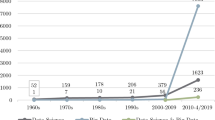Abstract
Eugene Garfield ubiquitous presence in scientometrics masks to some extent his influential contributions in diverse areas. Taking this as a premise for this study, the article attempts to trace Garfield’s contributions in four key domains: in data analytics, in influencing scholars involved in the study of science as an epistemic practice and a knowledge product, his engagement with scholars in developing countries and in innovation and entrepreneurship. The article however provides only a glimpse of his deep engagement in the above domains. The study concludes by arguing for scientometrics to develop strong connect with the different strands of research in science studies and other cross-disciplinary areas which pioneer like Garfield undertook through his writings, developing social networks and creating knowledge products.
Similar content being viewed by others
Notes
PageRank builds upon citation linkages concept to identify important web pages. Importance of a webpage is decided on two criteria (a) backlinks from other web pages which are similar to academic citations and (b) distinguishing each backlink in terms of their importance. A webpage citation can be more important than another webpage citation if a citing webpage has higher backlinks then the other. Thus a page has high rank if the sum of the ranks of its backlinks is high; covers both the case when the page has many backlinks and when a page has a few highly ranked backlinks (see for example The Page Rank Citation Ranking: Bringing Order to the Web (http://ilpubs.stanford.edu:8090/422/1/1999-66.pdf).
Kuhn has described scientific activity in terms of oscillating patterns of development (biphasic model), oscillating between paradigmatic growth (‘normal science’) and revolutionary turmoil. He characterised ‘normal science’ as puzzle solving during which all participants in a given area work in the same direction. Revolutionary science applies to episodes during which fundamental changes are made to basic concepts leading to discarding the established paradigm. Kuhn also classifies pe-paradigmatic phase which he attributes as immature science open to all kinds of external” influences.
References
Becker, M. C., Knudsen, T., & Swedberg, R. (2012). Schumpeter’s theory of economic development: 100 years of development’. Journal of Evolutionary Economics, 22(5), 917–933.
Braun, T., Glanzel, W., & Schubert, A. (2010). The footmarks of eugene in the journal scientometrics. Annals of Library and Information Science, 57, 177–183.
Callon, M., Law, J., & Rip, A. (1986). How to study the force of science. In M. Callon, J. Law, & A. Rip (Eds.), Mapping the dynamics of science and technology: Sociology of science in real world (pp. 3–15). London: The Macmillan Press Ltd.
De Mey, M. (1982). The cognitive paradigm. Holland: D. Reidel Publishing Company.
Edge, D. (1995). Reinventing the wheel. In S. Jasanoff, G. E. Markle, J. C. Petersen, & T. Pinch (Eds.), Handbook of science and technology studies (pp. 3–23). Sage Publications.
Garfield, E. (1955). Citation indexes for science: A new dimension in documentation through association of idea. Science, 122(3159), 108–111.
Garfield, E. (1971). Citation indexing, historio-bibliography and the sociology of science biography. Current Contents, No. 15, April 14. http://garfield.library.upenn.edu/essays/V1p132y1962-73.pdf.
Garfield, E. (1979). Citation indexing—Its theory and application in science, technology and humanities. New York: Wiley.
Garfield, E. (1983). Mapping science in the third world. Science and Public Policy, 10(3), 112–127.
Garfield, E. (1987). How to boost third world science. The Scientist. https://www.the-scientist.com/?articles.view/articleNo/8714/title/How-to-Boost-Third-World-Science/.
Garfield, E. (2003). Using HistCite to map the output of small world, watson-crick 1953, Cell Death and Differentiation, P. Nicotera, and Gene Flow. http://garfield.library.upenn.edu/papers/leicester071103.pdf.
Garfield, E. (2007). The evolution of the science citation index, search engine to the web-of-science, scientometric evaluation and historiography. http://garfield.library.upenn.edu/papers/barcelona2007.pdf.
Herther, N. K. (2007). Eugene Garfield launches HistCite. http://newsbreaks.infotoday.com/NewsBreaks/Eugene-Garfield-Launches-HistCite-40024.asp.
James, W. (1897). The will to believe and other essays in popular philosophy. Harlow: Longmans, Green & Co.
Kuhn, T. S. The structure of scientific revolution. Chicago: University of Chicago Press, 1963 (1st Edition), 1970 (2nd Edition).
Merton, R. K. (1979). Foreword. In E. Garfield (Ed.), Citation indexing—Its theory and application in science, technology and humanities (pp. i–ix). New York: Wiley.
Pinch, T. (2009). Merton’s sociology of science. https://understandingsociety.blogspot.in/2009/12/mertons-sociology-of-science.html.
Price, D. J. (1963). Little science, big science…and beyond. New York: Columbia University Press.
Price, D. J. (1965). Networks of scientific papers. Science, 149(3683), 510–515.
Sen, B. K. (2014). Eugene Garfield—Glimpses of his writings. Journal of Scientometric Research, 3(1), 57–60.
Sledzik, K. (2013). Schumpeter’s view on innovation and entrepreneurship. In Management Trends in Theory and Practice, (ed.) Stefan Hittmar. https://papers.ssrn.com/sol3/papers.cfm?abstract_id=2257783.
Author information
Authors and Affiliations
Corresponding author
Rights and permissions
About this article
Cite this article
Bhattacharya, S. Eugene Garfield: brief reflections. Scientometrics 114, 401–407 (2018). https://doi.org/10.1007/s11192-017-2620-7
Received:
Published:
Issue Date:
DOI: https://doi.org/10.1007/s11192-017-2620-7




